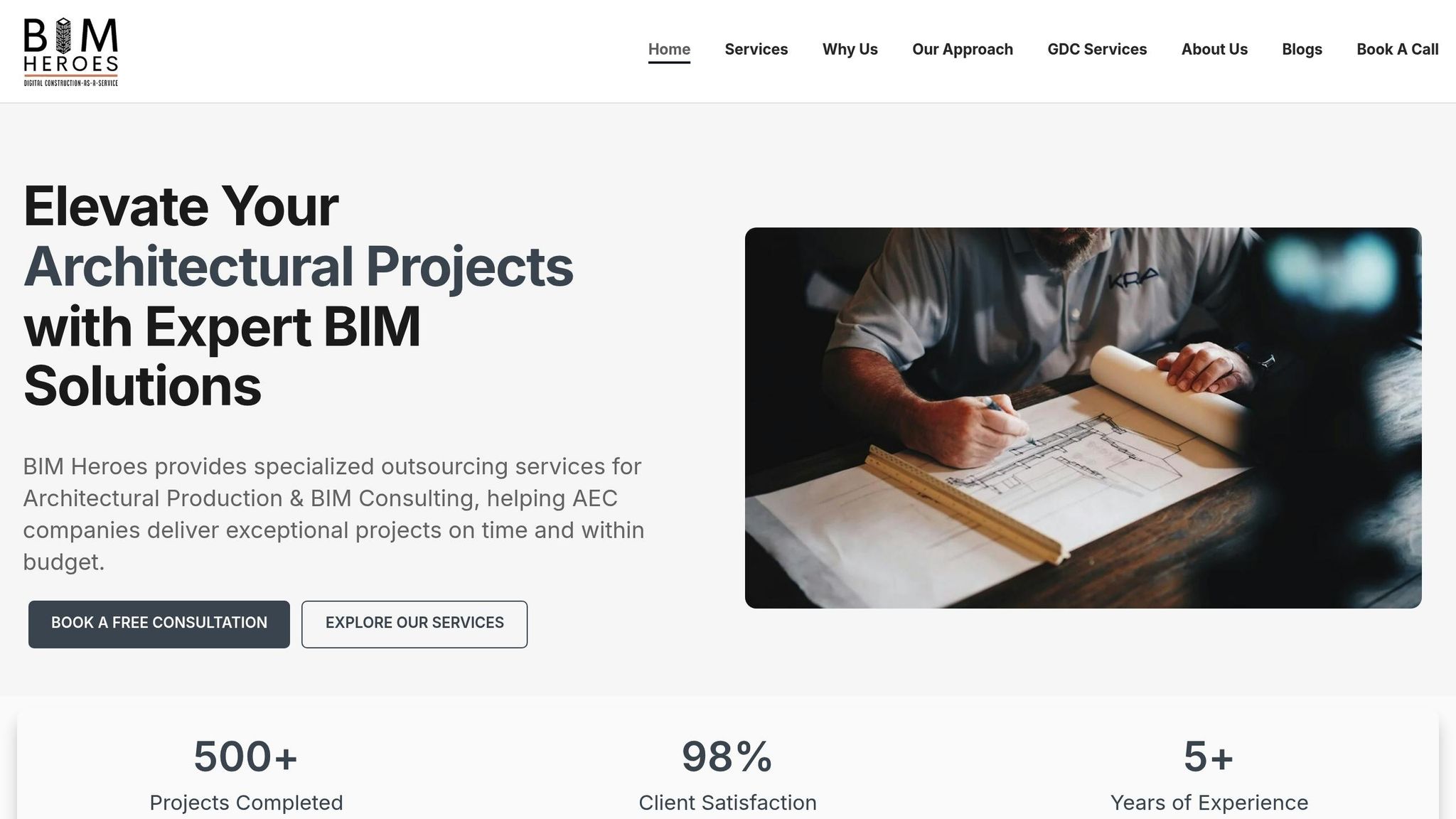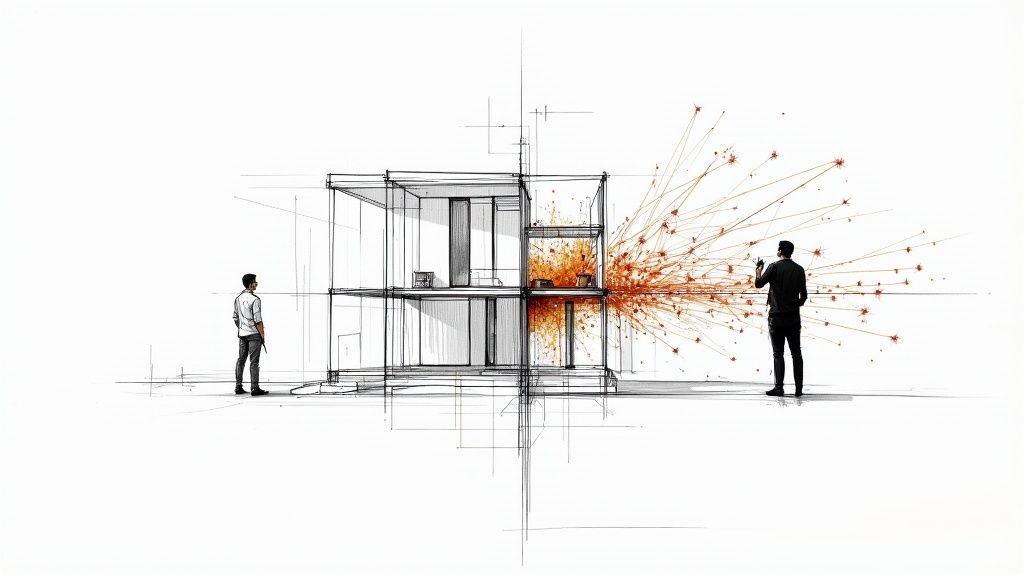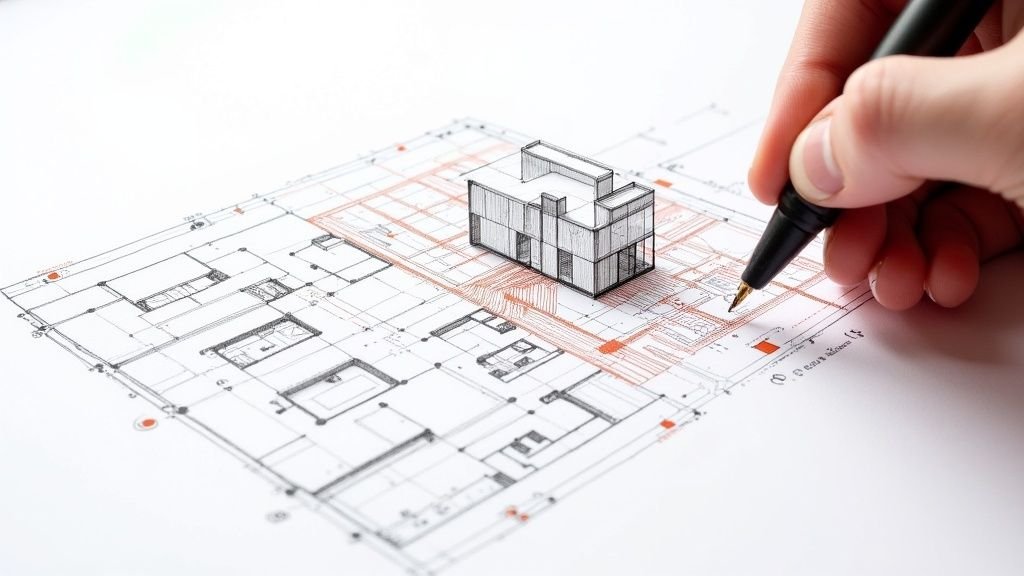Is AI Coming for Drafters? What It Means for You
Is AI Coming for Drafters? What It Means for You
AI is transforming drafting work, automating repetitive tasks, and enabling faster design processes. Tools like Autodesk‘s Revit and Forma can generate multiple layouts, optimize materials, and review designs against building codes in minutes. By 2025, 75% of large organizations are expected to use AI-driven tools, with the U.S. architecture software market growing at 16.2% annually. While AI boosts productivity (cutting delays by 20% and budget overruns by 30%), it also demands new skills. Currently, 60% of professionals lack formal AI training, creating a gap – and an opportunity – for those willing to learn.
Key Points:
- AI in Drafting: Automates tasks like floor plans, clash detection, and material recommendations.
- Impact on U.S. Drafters: Enhances efficiency but requires upskilling to stay competitive.
- Job Security: AI supports creativity but shifts roles toward collaboration and oversight.
- Training Needs: Combining CAD expertise with AI skills, like Python or prompt engineering, is critical.
- Challenges: Poor data organization and maintaining compliance with U.S. building codes remain hurdles.
AI isn’t replacing drafters but reshaping their roles. Those who learn to work with AI will thrive in this evolving industry.
Will AI replace CAD professionals job?
The Problem: AI Disrupts Current Drafting Methods
AI is shaking up the drafting profession, fundamentally altering the way traditional workflows are carried out. This rapid transformation is forcing professionals to reevaluate their roles as automation becomes a bigger part of the industry.
By 2025, experts predict that 75% of large organizations will have integrated AI-driven tools into their core operations. For drafting professionals, this means traditional CAD workflows – once predictable and methodical – may soon be replaced by AI systems capable of generating designs, spotting errors, and optimizing solutions in ways that were previously unimaginable. McKinsey estimates that spending on generative AI technology could reach between $175 billion and $250 billion by 2027. This level of investment highlights how deeply AI is reshaping the architectural and construction landscape. While these advancements promise efficiency and innovation, they also bring pressing questions about the future of drafting roles.
Drafting Tasks Most Affected by AI
Not all drafting tasks are equally impacted by AI. Repetitive, rule-based tasks – like creating floor plans, elevations, and construction details – are particularly susceptible to automation. AI systems thrive in handling these kinds of standardized, repetitive jobs.
A recent AECO survey revealed that 39% of respondents identified automating mundane, repeatable tasks as a primary use case for AI. For instance, Patriarche, an architecture firm, slashed the time needed for volume studies from two days to just one-and-a-half hours by using Autodesk Forma. Similarly, MBH Architects used Forma to streamline design options for The Phoenix project, cutting the process from two weeks to just six hours.
AI’s impact isn’t limited to drafting. Tasks like data entry, clash detection in BIM, and project scheduling are also being automated. These systems can now process point clouds, detect conflicts among building systems, and optimize project timelines with minimal human input. Even early-stage design work is seeing change, as AI tools generate functional floor plans that align with project requirements and regulatory standards.
Job Security and Skills Concerns
As automation takes over routine tasks, traditional drafting roles are undergoing a significant shift. Many professionals are worried about job security and the long-term stability of their careers. According to PwC’s 2023 Global Workforce Hopes & Fears Survey, 44% of workers globally fear losing their jobs to automation, and nearly 60% are concerned about their employment stability in the future. Beyond job loss, the rapid pace of automation is forcing drafting professionals to develop new skills to remain relevant.
Survey results show that 85% of respondents believe adopting AI will require them to take on new roles and learn new skills. Many drafting professionals now face a tough balancing act: maintaining their CAD expertise while adapting to AI-powered tools. This growing skills gap has led to increased anxiety about career longevity and professional relevance. While AI boosts efficiency, it also demands that professionals evolve their skill sets to keep pace with the changing landscape.
At the same time, the demand for new roles – such as AI specialists, IT and cybersecurity experts, AI implementation managers, and trainers – is on the rise. McKinsey’s research also suggests that generative AI could increase vendor switching by five to ten percentage points. With economic pressures mounting, drafting professionals must embrace new technologies and redefine their roles to stay competitive in this shifting environment.
AI Solutions That Transform Drafting Work
AI is reshaping the way drafting work is done. It’s not just about automating tasks – it’s about making processes faster, reducing errors, and opening up new design possibilities.
A recent survey found that 46% of architects are already using AI tools, with another 23% planning to adopt them soon. These tools are delivering measurable results: 44% of AECO survey respondents highlighted increased productivity as a key benefit of using AI.
AI Features in Popular Drafting Software
Leading software platforms are incorporating AI to tackle everyday drafting challenges. Autodesk is at the forefront, integrating AI into tools like Revit and AutoCAD. For example, at the Phoenix project in West Oakland, CA, MBH Architects used Autodesk’s Forma to optimize costs, carbon impact, and livability in real time. This reduced design time from two weeks to just six hours.
AI-powered features are transforming several areas of drafting:
- Clash Detection: AI can now identify conflicts between architectural, MEP, and structural elements before construction starts, saving time and resources.
- Generative Design: Architects can input parameters like room requirements and building codes, and AI generates multiple design options in minutes – work that used to take days or even weeks.
- Submittal Reviews: AI speeds up the review process, cutting down on administrative tasks and letting architects focus on design.
- Point Cloud Processing: AI streamlines the conversion of 3D scans into usable BIM models, automating tasks like identifying building elements and classifying objects.
These advancements are helping firms like BIM Heroes seamlessly integrate cutting-edge tools into their workflows.
BIM Heroes: Supporting U.S. Clients with AI and BIM Skills

BIM Heroes is leading the charge in combining traditional BIM expertise with AI-driven solutions. They offer full architectural production services, from initial concepts to construction documentation, while using AI to streamline workflows and shorten project timelines. Their consulting services also guide firms in adopting AI, helping them set standards and optimize processes.
What sets BIM Heroes apart is their ability to integrate advanced tools without disrupting existing workflows. Their services include Point Cloud to BIM conversion, enhanced 3D modeling, and visualization, allowing for rapid design iterations.
"BIM Heroes transformed our workflow with their expertise. Their team delivered exceptional quality on a tight deadline, & their attention to detail was impressive. They’ve become an invaluable extension of our design team."
- Michael Thompson, Principal Architect
Their dedicated team model provides U.S. clients with access to high-level BIM expertise without the need to hire or train in-house staff. This approach is especially timely, as 76% of AECO organizations plan to increase investments in AI and emerging technologies over the next three years.
"Working with BIM Heroes has been a game-changer for our firm. Their BIM consulting services helped us standardize our processes and significantly reduce coordination issues. The ROI has been tremendous."
- Sarah Johnson, Project Manager
BIM Heroes follows a structured approach, incorporating AI at every stage – from discovery and planning to execution and quality assurance.
AI-Powered vs. Standard Drafting Methods
The differences between AI-enhanced and traditional drafting methods are increasingly clear. Here’s a side-by-side comparison:
| Aspect | AI-Powered Methods | Standard Drafting Methods |
|---|---|---|
| Design Generation | Generates multiple design options in minutes based on set parameters | Requires manual creation of each design iteration |
| Error Detection | Automated clash detection and real-time error checking | Relies on manual review and coordination meetings |
| Documentation Time | Cuts documentation time by 50% | Follows traditional, slower timelines |
| Revision Handling | Automatically updates all related drawings | Requires manual updates to each affected drawing |
| Quality Consistency | Produces standardized output with fewer errors | Varies depending on individual drafter’s skill |
| Learning Curve | Requires training on AI tools | Relies on established CAD skills |
| Cost Structure | Higher software costs but lower labor hours | Lower software costs with higher labor expenses |
| Scalability | Handles large volumes efficiently | Limited by human resources |
The productivity gains are undeniable. AI tools can improve productivity by 14% to 55%, depending on the task. For drafting specifically, these tools can cut task completion time by 37% and enhance work quality by 15%. However, proper training is crucial to fully unlock these benefits.
The real strength of AI lies in its ability to handle repetitive, rule-based tasks, freeing up professionals to focus on creative problem-solving and client interactions. Firms that embrace these tools are gaining a competitive edge, delivering projects faster and with higher quality. By adopting AI, drafting professionals can not only tackle traditional challenges but also redefine their roles in the ever-evolving AEC industry.
sbb-itb-0af4724
How Drafters Can Adapt and Succeed
The rise of AI in drafting is reshaping the industry, and those who embrace these changes are finding exciting opportunities for growth and creativity. By letting AI handle repetitive tasks, drafters can focus on more meaningful work. Between 2015 and 2019, the demand for professionals with AI and machine learning expertise tripled. Adapting to these shifts isn’t just helpful – it’s essential for thriving in this new landscape.
Mastering AI-Enhanced Tools
To stay ahead, drafters should combine traditional drafting skills with AI know-how. Learning programming languages like Python, Java, and SQL is a great starting point. These skills allow professionals to train AI systems using existing templates and drawings, as well as set automation parameters that align with company standards.
Recent trends highlight this shift: in 2023, traditional drafting skills accounted for 50% of job requirements, but by 2024, that number dropped to 31%. Meanwhile, demand for AI and machine learning skills jumped from 7% to 21% over the same period. Developing prompt engineering skills – essentially learning how to communicate effectively with AI – is becoming a valuable asset. A solid understanding of machine learning can also help drafters use AI for tasks like object recognition, error detection, and automated plan generation.
AI isn’t here to replace designers but to work alongside them. By automating tedious tasks, AI frees up time for professionals to focus on creative and impactful projects. This shift not only enhances productivity but also opens doors to entirely new roles in drafting.
Exploring New Roles and Career Paths
AI is creating opportunities in roles like BIM coordinators and AI workflow specialists, all while preserving tasks that require human creativity and judgment. Areas such as client relations, problem-solving, collaboration across disciplines, and navigating regulations remain firmly in the hands of humans.
Critical thinking is key in this evolving field, offering drafters the chance to refine and improve AI-assisted designs. Architecture schools are already preparing students for this future by incorporating AI into their programs. As Igor Siddiqui, a professor at UT Austin, puts it:
"AI will free students to increasingly use emotional intelligence, soft skills, cognitive flexibility, communication, creativity, and empathy".
Human insight is still crucial for tasks like site analysis, community engagement, and understanding local building codes. These elements require a nuanced approach that AI can’t replicate, ensuring that human expertise remains central to effective design.
Collaborating with Experts Like BIM Heroes
To bridge the gap between current skills and future demands, teaming up with experts like BIM Heroes can make all the difference. BIM Heroes provides a phased approach to integrating AI, starting with smaller projects to build confidence before scaling up. Their training programs equip internal teams with the skills needed to adopt AI tools effectively.
Through their dedicated team model, BIM Heroes allows professionals to collaborate with AI specialists who handle the technical aspects of implementation. This setup lets in-house teams focus on design intent and quality control. By working together, drafters can refine AI-generated suggestions, ensuring the final designs meet both technical standards and creative goals.
This partnership not only delivers immediate results but also serves as hands-on training for a future where AI and human creativity go hand in hand.
Challenges: Managing the AI Transition
AI brings exciting possibilities for drafting professionals, but the shift to integrating these tools isn’t without its obstacles. In fact, 74% of companies struggle to achieve scalable value from AI, and over 90% face difficulties merging AI with their existing systems. By understanding these hurdles, drafting professionals and firms can better prepare for a smoother transition. Beyond these systemic obstacles, there are also ethical and practical considerations tied to AI adoption.
Ethics and Practical Issues
Bringing AI into drafting workflows introduces a range of ethical and practical challenges. One of the biggest hurdles? Disorganized data. According to a survey, 83% of IT leaders identify poor data organization as a key factor slowing down AI automation adoption. If CAD files, databases, or drawing standards are messy or inconsistent, AI tools will produce unreliable results.
The quality of your data plays a massive role here. AI systems learn from your existing drawings and templates, meaning any errors or outdated standards in those files will be amplified. This creates a domino effect where automated outputs need extensive manual correction, which defeats the purpose of using AI in the first place.
Another major issue is transparency in AI decision-making, especially in regulated fields like architecture and construction. For example, when an AI tool suggests design changes or flags code violations, professionals need to understand the reasoning behind these recommendations. Without explainability features, accountability becomes a challenge. Selecting AI tools that prioritize transparency – or pairing them with technologies that can interpret their decisions – can help address this.
While AI shines at repetitive tasks, it lacks the nuanced understanding needed for complex design decisions. This limitation becomes even more apparent when trying to comply with constantly changing U.S. building codes.
Meeting U.S. Building Code Requirements
Keeping up with the complexity and frequent updates of U.S. building codes is a big ask for AI systems. However, there are promising examples of progress in this area.
In October 2024, Altamonte Springs, Florida, introduced an automated AI-powered site plan review system. City Manager Frank Martz highlighted the efficiency of the tool, saying, "It might take a staff employee a few weeks to get through one plan, while AI can do it in as little as 30 minutes". Similarly, Pasco County, Florida, implemented AI software to review plans for zoning and landscaping compliance. Chairman Jack Mariano remarked:
"Using technology like this will significantly improve our ability to ensure that the development approval process is transparent, and our codes are absolutely enforced".
Even with these advancements, human oversight remains essential. AI tools can be updated in real-time with the latest regulatory changes, but qualified professionals must validate compliance decisions. Drafting teams should integrate AI as a screening tool while continuing to review designs manually during pre-construction meetings and maintaining accurate documentation for compliance.
Staying Competitive Through Learning
Overcoming these challenges requires a commitment to learning and support from leadership. The rapid pace of AI development means professionals must continually adapt. Currently, only 8% of firm leaders report fully integrating AI into their practices, and while 53% of architects have experimented with AI, only 6% use it consistently. This gap presents both a challenge and an opportunity for those ready to embrace change.
Leadership support is crucial. In fact, 29% of organizations cite a lack of executive backing as a primary obstacle to AI adoption. Without this support, drafters may miss out on training, tools, and time to develop the skills needed for effective AI use.
The learning curve can be steep, but investing in training pays off. Firms can organize hack days or build sprints focused on AI, encourage leaders to share how they’re personally using these tools, and create internal channels to exchange tips and lessons learned. Allowing flexible timelines for AI experiments can also help professionals build confidence without added pressure.
Organizations like BIM Heroes are tackling these challenges head-on. Their phased approach to AI integration combines hands-on training with real-world projects, ensuring drafters gain experience without risking project quality or deadlines. This collaborative model helps bridge skill gaps while maintaining high standards.
The key is to view AI as an evolving skill, not a one-size-fits-all directive. Start small with low-risk, high-reward applications, and create an environment where professionals feel comfortable sharing both successes and failures. As David Rowlands, KPMG’s global head of AI, puts it:
"Organizations will be increasingly differentiated by the data that they own".
This underscores the importance of investing in data governance – cleaning up project files, organizing information, and building systems that support AI from the ground up. Successfully managing the transition to AI requires addressing both technical and human challenges, with workplace culture playing just as critical a role as technology.
Conclusion: Using AI as a Growth Tool
The reality is clear: AI isn’t just on the horizon for drafters – it’s already a part of the landscape. For the drafting profession, AI represents a chance to grow and evolve in ways that were unimaginable just a few years ago.
The numbers speak volumes. Ninety-two percent of companies plan to increase their AI investments, and in the U.S., AI-related job listings have jumped by 56.1%. This isn’t a fleeting trend; it’s a seismic shift, opening doors for those ready to integrate AI into their work.
Yehia Madkour from Perkins&Will captures the essence of this change:
"It’s not really about losing jobs. It will be about losing jobs to people who use AI."
This statement highlights the challenge and opportunity for drafting professionals. AI isn’t here to replace drafters but to elevate those who adapt. By automating repetitive tasks, AI allows professionals to redirect their energy toward creative problem-solving, client interactions, and tackling complex design challenges – areas where human insight remains indispensable.
We’re already seeing the rise of hybrid roles that blend technical know-how with creativity and communication. Interestingly, design skills now surpass coding as the top demand in AI-specific job listings, reinforcing the idea that human ingenuity continues to be irreplaceable in an AI-driven world.
Take BIM Heroes as an example. Their approach to integrating AI into drafting workflows is a model for success. By combining practical training with real-world projects, they help U.S. drafting professionals develop AI expertise without compromising project quality. Whether through dedicated teams for long-term AI adoption or flexible hourly arrangements to test new tools, they bridge the gap between traditional methods and AI-enhanced processes.
Sam Altman, cofounder and CEO of OpenAI, offers an inspiring perspective:
"People are using [AI] to create amazing things. If we could see what each of us can do 10 or 20 years in the future, it would astonish us today."
AI isn’t about replacing human expertise; it’s about amplifying it. Used thoughtfully, AI can enhance traditional drafting workflows, freeing professionals to focus on the aspects of design that only humans can master.
The future belongs to those who combine technical fluency with creativity and leadership. For drafters, embracing AI isn’t about stepping aside – it’s about stepping up. AI offers an opportunity to achieve new levels of efficiency and creativity, magnifying the unique value that human talent brings to the table.
FAQs
How can drafting professionals prepare to use AI in their workflows?
Drafting professionals can get ahead in the AI era by prioritizing ongoing education and honing skills tailored to AI-powered tools. Consider diving into online courses or attending workshops on topics like generative design, machine learning, and automated drafting software. Partnering with seasoned colleagues or mentors who already use AI tools can also offer practical tips and guidance.
When incorporating AI into your work, start by pinpointing areas in your process where it can make a difference – think early-stage design, clash detection, or 3D modeling. Experiment with AI-enhanced tools, such as those available in Revit or AutoCAD, to automate repetitive tasks and boost precision. Keeping an open mind and staying updated on tech advancements will help you stay competitive in this fast-changing field.
What ethical challenges does AI bring to drafting, and how can they be addressed?
AI’s role in drafting brings up some serious ethical challenges, such as bias, transparency issues, and data privacy risks. To use AI responsibly, it’s crucial to ensure these systems are clear in their operations and avoid producing unfair or discriminatory outcomes.
Transparency involves making AI’s decision-making processes easy to understand, helping users feel confident in the system’s choices. On top of that, the data feeding these tools must be securely managed and well-organized to prevent misuse or breaches. Tackling these concerns allows drafting professionals to integrate AI into their work without compromising ethical standards.
How can drafting professionals ensure their designs comply with U.S. building codes when using AI tools?
Drafting professionals can ensure their designs comply with U.S. building codes by using AI-powered tools that automatically review and analyze plans for adherence to regulations. These tools help spot potential violations, offer suggestions for fixes, and simplify the approval process, making it easier to meet the latest standards.
To make these tools as dependable as possible, firms should focus on AI solutions that prioritize clarity and transparency. This means the system’s recommendations should be easy to understand and verify. Keeping AI systems updated with the latest code revisions and combining them with human expertise ensures not only accuracy but also preserves the creative and critical thinking that humans bring to the drafting process.






